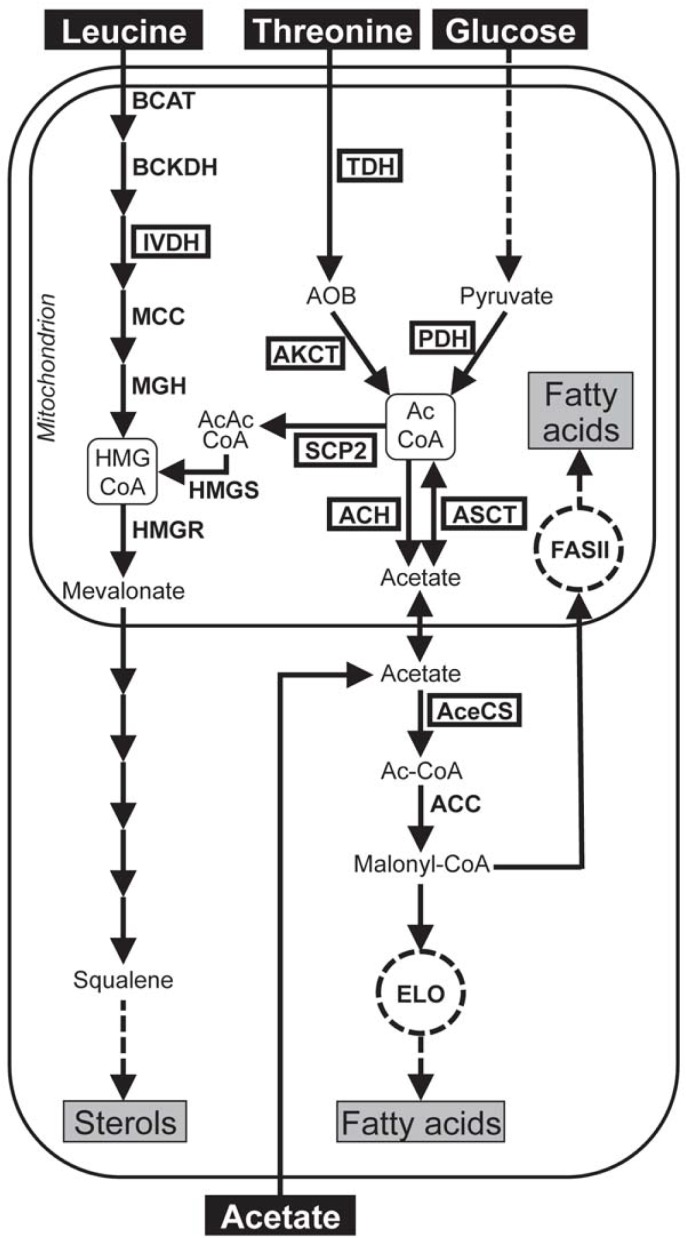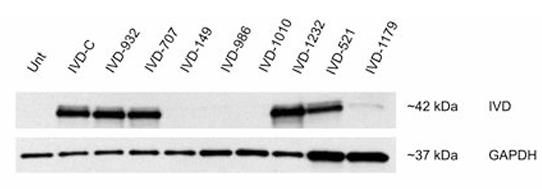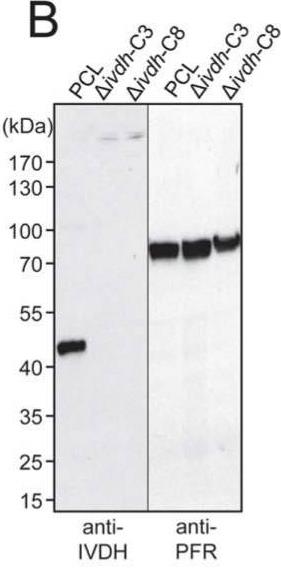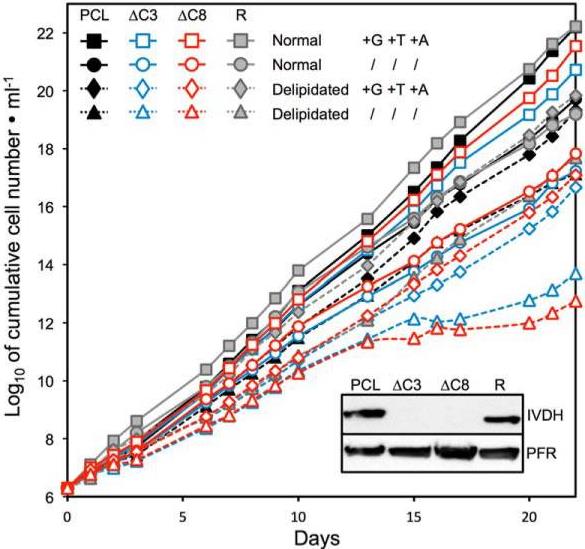IVD
-
Official Full Name
isovaleryl-CoA dehydrogenase -
Overview
Isovaleryl-CoA dehydrogenase (IVD) is a mitochondrial matrix enzyme that catalyzes the third step in leucine catabolism. The genetic deficiency of IVD results in an accumulation of isovaleric acid, which is toxic to the central nervous system and leads to isovaleric acidemia. Alternatively spliced transcript variants encoding different isoforms have been found for this gene. -
Synonyms
IVD;isovaleryl-CoA dehydrogenase;isovaleryl CoA dehydrogenase , isovaleryl Coenzyme A dehydrogenase;isovaleryl-CoA dehydrogenase, mitochondrial;ACAD2;mitochondrial;FLJ12715;FLJ34849;Isovaleryl CoA dehydrogenase;Isovaleryl CoA dehydrogenase, mitochondrial;Isovaleryl Coenzyme A dehydrogenase;IVD_HUMAN
Recombinant Proteins
- Zebrafish
- Human
- Rat
- Chicken
- Mouse
- Mammalian Cells
- E.coli
- Insect Cells
- HEK293
- Wheat Germ
- In Vitro Cell Free System
- His
- T7
- Non
- DDK
- Myc
- Avi
- Fc
- GST
| Cat.# | Product name | Source (Host) | Species | Tag | Protein Length | Price |
|---|---|---|---|---|---|---|
| IVD-11536Z | Recombinant Zebrafish IVD | Mammalian Cells | Zebrafish | His |
|
|
| IVD-1943H | Recombinant Human Isovaleryl Coenzyme A dehydrogenase, His-tagged | E.coli | Human | His |
|
|
| IVD-29875TH | Recombinant Human IVD, His-tagged | E.coli | Human | His | 394 amino acids |
|
| IVD-29876TH | Recombinant Human IVD, His-tagged | E.coli | Human | His | Full L. 30-423 a.a. |
|
| IVD-3129R | Recombinant Rat IVD Protein | Mammalian Cells | Rat | His |
|
|
| IVD-4390C | Recombinant Chicken IVD | Mammalian Cells | Chicken | His |
|
|
| Ivd-8172M | Recombinant Mouse Ivd protein, His & T7-tagged | E.coli | Mouse | His&T7 | Met1~Phe235 |
|
| IVD-8642H | Recombinant Human IVD protein, His-tagged | Insect Cells | Human | His | His30-His423 |
|
| IVD-001HCL | Recombinant Human IVD cell lysate | Insect Cells | Human | Non | 30-423 a.a. |
|
| IVD-2644H | Recombinant Human IVD Protein, MYC/DDK-tagged | HEK293 | Human | DDK&Myc |
|
|
| IVD-2785R | Recombinant Rat IVD Protein, His (Fc)-Avi-tagged | HEK293 | Rat | Avi&Fc&His |
|
|
| IVD-2785R-B | Recombinant Rat IVD Protein Pre-coupled Magnetic Beads | HEK293 | Rat |
|
||
| Ivd-3623M | Recombinant Mouse Ivd Protein, Myc/DDK-tagged | HEK293 | Mouse | DDK&Myc |
|
|
| IVD-4942H | Recombinant Human IVD Protein, GST-tagged | Wheat Germ | Human | GST |
|
|
| IVD-5848HF | Recombinant Full Length Human IVD Protein, GST-tagged | In Vitro Cell Free System | Human | GST | Full L. 423 amino acids |
|
| IVD-5996H | Recombinant Human IVD Protein, Myc/DDK-tagged, C13 and N15-labeled | HEK293 | Human | DDK&Myc |
|
|
| IVD-876M | Recombinant Mouse IVD Protein (His31-Arg424), His-tagged | Insect Cells | Mouse | His | His31-Arg424 |
|
Background
What is IVD Protein?
IVD protein, or isovaleryl-CoA dehydrogenase, is an enzyme involved in breaking down the amino acid leucine inside mitochondria. It helps turn leucine into energy. When the IVD protein malfunctions, it can cause isovaleric acidemia, a metabolic disorder. This condition might result in symptoms such as strange body odor and, in severe situations, neurological issues. Understanding how IVD operates is key to diagnosing and managing these metabolic challenges.What is the Function of IVD Protein?
The IVD protein, known as isovaleryl-CoA dehydrogenase, is super important for breaking down the amino acid leucine in our mitochondria. Think of it like a key part of our body's power plant, helping turn what we eat into energy we need to move and think. When this protein doesn't work quite right, it can lead to a metabolic issue called Isovaleric Acidemia. This means certain toxic substances can build up, causing problems like feeling sick, really tired, or even having a unique "sweaty feet" smell. So, the IVD protein is all about making sure our body's engine runs smoothly by handling nutrients from our food.
Fig1. Schematic representation of fatty acid and sterol de novo biosynthesis in procyclic trypanosomes. (Yoann Millerioux, 2018)
IVD Related Signaling Pathway
The IVD protein doesn’t just hang out by itself; it’s linked to a bunch of different chemical signals in our cells that make up what’s called a signaling pathway. Basically, these pathways are like relay races. One molecule passes a “baton” to the next, and this protein is often a key player in pathways that manage energy production and metabolic processes. Sometimes, issues with these pathways can lead to problems in breaking down nutrients properly. For instance, it can impact things like fatty acid metabolism. When these pathways don’t run smoothly, it can disrupt energy balance in the body, leading to various metabolic disorders. So, IVD is pretty much a star in these pathways, ensuring everything from your energy levels to how efficiently your body uses nutrients, stays on track.IVD Related Diseases
When IVD, or isovaleryl-CoA dehydrogenase, isn't doing its job right, it can cause a rare condition called Isovaleric Acidemia. This is basically a hiccup in the body's ability to break down leucine, one of those amino acids we get from food. Kids with this condition might suddenly start vomiting or seem really tired. One unusual sign is a sweaty feet smell, which is a tell-tale giveaway due to certain compounds building up. If caught early, with things like special diets or medications, folks can manage pretty well. But without attention, it can lead to more serious health issues. So, keeping an eye on how this protein works is key to avoiding or managing these kinds of metabolic bumps in the road.Bioapplications of IVD
IVD protein is finding some cool uses in biotechnology. Beyond its critical role in metabolism, scientists are diving into how this protein helps us understand metabolic disorders like Isovaleric Acidemia. By studying IVD, they're working on better treatments that are tailored to the individual's needs. But that's not all—IVD is also making waves in the world of metabolic engineering. Researchers are tweaking it to improve processes like producing biofuels or other valuable substances using renewable resources. By figuring out and adjusting how IVD operates, they can create more efficient systems for these purposes. So, whether it's in medical research or sustainable industry, IVD is proving to be quite the versatile player.Case Study
Case Study 1: D'Annibale OM. et al. Mol Genet Metab. 2021
Newborn screening uses mass spectrometry to spot issues, but it often finds uncertain variants (VUS) that complicate diagnosing disorders like isovaleric acidemia (IVA). IVA stems from a lack of IVDH enzyme, with some mutations being unclear. Using CRISPR/Cas9, researchers made a cell model to test these VUS. Some mutations, such as p.Arg50Pro, showed reduced enzyme activity, while others like p.Val174Gly were normal. This method helps clarify VUS roles, aligning with IVA fibroblast findings.-
 Fig1. Western blot for IVDH confirms its absence in clonal lines.
Fig1. Western blot for IVDH confirms its absence in clonal lines. -
 Fig2. Detection of IVDH protein levels by western blot to evaluate protein stability.
Fig2. Detection of IVDH protein levels by western blot to evaluate protein stability.
Case Study 2: Millerioux Y. et al. PLoS Pathog. 2018
In Trypanosoma brucei, threonine, acetate, and glucose fuel both fatty acid and sterol production, while leucine is mostly for sterols in tsetse flies. Blocking key genes disrupts this balance, boosting fatty acid production. The parasites need ketogenic sources for growth, underscoring the mevalonate pathway's importance. Fatty acid synthesis is prioritized over sterols, with leucine as a primary sterol source in the fly’s gut.-
 Fig3. Western blot analysis of the EATRO1125.T7T, Δivdh-C3 and Δivdh-C8 cell lines.
Fig3. Western blot analysis of the EATRO1125.T7T, Δivdh-C3 and Δivdh-C8 cell lines. -
 Fig4. IVDH is needed for growth of PCF in medium depleted in ketogenic carbon sources.
Fig4. IVDH is needed for growth of PCF in medium depleted in ketogenic carbon sources.
Quality Guarantee
High Purity
-
.jpg) Fig1. SDS-PAGE (IVD-4942H)
Fig1. SDS-PAGE (IVD-4942H) -
.jpg) Fig2. SDS-PAGE (IVD-5996H)
Fig2. SDS-PAGE (IVD-5996H)
Involved Pathway
IVD involved in several pathways and played different roles in them. We selected most pathways IVD participated on our site, such as Branched-chain amino acid catabolism,Metabolic pathways,Metabolism, which may be useful for your reference. Also, other proteins which involved in the same pathway with IVD were listed below. Creative BioMart supplied nearly all the proteins listed, you can search them on our site.
| Pathway Name | Pathway Related Protein |
|---|---|
| Metabolic pathways | CKM,ATP5L,LIPG,ENO2,NDUFC2,ADH4,AMACR,UPRT,CKMT2,CYP2A12 |
| Valine, leucine and isoleucine degradation | BCAT2,HADH,ACAA1A,BCAT1,AOX2P,DLDH,ACAT2,AOX1,OXCT1A,ACAD8 |
| Branched-chain amino acid catabolism | PPM1K,DLD,HIBADHA,BCKDK,ALDH9A1A.2,HIBADH,DBT |
| Metabolism of amino acids and derivatives | CKMT2,SLC6A8,CTHL,DIO2,OAZ3,GLS2B,DAO,CDO1,UROC1,TPH2 |
| Metabolism | GRHL1,FIG4,PLIN2,ATP5L,ADSL,SAT1B,NUBP1,APOEB,ACOT10,CTRB1 |
Protein Function
IVD has several biochemical functions, for example, electron carrier activity,fatty-acyl-CoA binding,flavin adenine dinucleotide binding. Some of the functions are cooperated with other proteins, some of the functions could acted by IVD itself. We selected most functions IVD had, and list some proteins which have the same functions with IVD. You can find most of the proteins on our site.
| Function | Related Protein |
|---|---|
| flavin adenine dinucleotide binding | ACAD11,FMO5,MAOB,NOX5,ACADSB,DLD,ACOX3,FMO1,SQLE,D2HGDH |
| electron carrier activity | GSR,TXNRD1,FDX1,NCF1,COX7A1,DERL3,ETFB,FDX1L,DHRS3,TSTA3 |
| oxidoreductase activity, acting on the CH-CH group of donors, with a flavin as acceptor | ACADVL,ACAD8,GCDH,ACOX2,ETFA,GCDHA,ACADL,ACOXL,ACADM,ACADSB |
| fatty-acyl-CoA binding | ACBD7,ACAD11,ALDH6A1,SCP2,ACBD5B,ECI2,ACADM,ACADL,GCDHB,HADHA |
Interacting Protein
IVD has direct interactions with proteins and molecules. Those interactions were detected by several methods such as yeast two hybrid, co-IP, pull-down and so on. We selected proteins and molecules interacted with IVD here. Most of them are supplied by our site. Hope this information will be useful for your research of IVD.
ssuA;SIRT4
Resources
Related Services
Related Products
References
- Koerner, JD; Markova, DZ; et al. Differential Gene Expression in Anterior and Posterior Annulus Fibrosus. SPINE 39:1917-1923(2014).
- Vashist, SK; Schneider, EM; et al. Rapid sandwich ELISA-based in vitro diagnostic procedure for the highly-sensitive detection of human fetuin A. BIOSENSORS & BIOELECTRONICS 67:73-78(2015).


